Comments / Questions (28)
![]() Lenoir wrote:
Lenoir wrote:
Il y a des marqueurs de chaque côté des cotes sur les côtés du pull De chaque côté des marqueurs il y a 10 mailles A quel endroit dois je diminuer les 6 mailles de l' emmanchure Merci je suis un peu perdue
26.05.2017 - 21:39DROPS Design answered:
Bonjour Mme Lenoir, vous rabattez les 3 mailles après le 1er marqueur, tricotez jusqu'à ce qu'il reste 3 m avant le 2ème marqueur, rabattez les 6 m suivantes (= 3 m avant + 3 m après le marqueur), continuez jusqu'à ce qu'il reste 3 m et rabattez les 3 dernières mailles. Bon tricot!
29.05.2017 - 08:56
![]() AIRI P-M wrote:
AIRI P-M wrote:
En ymmärrä ohjeesta kohtaa: Vaihda pyöröpuikkoon nro 4 ja neulo seuraava krs näin: 1 o, 2 n, 1 o, 1 n, neulo sileää neuletta kunnes jäljellä on 5 s ennen merkkilankaa, ja kavenna SAMALLA näiden silmukoiden kohdalla tasavälein 10-10-12-12-12 s, Tehdäänkö kavennukset 1, rivillä merkkilankojen välillä tasavälein? Vai mitä tuo tarkoittaa??
04.12.2016 - 20:28DROPS Design answered:
Hei! Kavennukset tehdään ensimmäisellä kerroksella sileän neuleen kohdalla. Eli joustinneuleen kohdalla ei kavenneta.
05.12.2016 - 14:00
![]() Lisa wrote:
Lisa wrote:
Det här mönstret funkar inte i storlek 92. Jag gjorde exakt som det stod (tog hjälp av kunniga väninnor så jag vet att jag gjorde rätt) men halsöppningen blev då alldeles för liten, inte en chans att få på den på min tvååring. Jag repade upp och började denna gång maska av för v-ringen flera cm tidigare, men det funkade inte då heller. Så jag är mycket besviken på detta mönster!
03.12.2016 - 15:59DROPS Design answered:
Hej Lisa. Saa maalene paa din tröje stemmer ikke overens med maalene nederst i maalskitsen? Og din strikkefasthed var korrekt?
22.12.2016 - 14:38
![]() Bernard GUILLON wrote:
Bernard GUILLON wrote:
Bonjour, j'ai téléchargé les explications de ce petit pull simple à tricoter, mais j'ai été surpris de ne pas y voir les côtes (d'après l'image des côtes 1/1). les explication commence directement sur le jersey. j'ai lu dans les questions que quelqu'un avait fait 4 cm de côtes, est-ce bien ça? mais ça me semble beaucoup en comparaison de l'image? merci d'avance
08.04.2016 - 22:08DROPS Design answered:
Bonjour Monsieur Guillon, on commence par tricoter 1 tour endroit, puis on continue en côtes ainsi pendant 4 cm: 1 m end, 2 m env, *1 m end, 1 m env*, répéter de *-* 33-35-38-40-42 fois au total (c'est-à-dire jusqu'à ce qu'il reste 4 m avant le marqueur, 1 m end, 2 m env, 2 m end (le marqueur se trouve entre ces 2 m), 2 m env, *1 m end, 1 m env*, répéter de *-* 33-35-38-40-42 fois au total et terminer par 1 m end, 2 m env et 1 m end. Bon tricot!
11.04.2016 - 12:13
![]() Bente Nielsen wrote:
Bente Nielsen wrote:
Vedr. halsudskæring kan jeg ikke få maskeantallet til at passe.
22.03.2016 - 15:29Sandra wrote:
My stockinette stitch doesn't seem right. It doesn't look like neat v stacking, but instead rows of slanted (\) stitch and rows of blurred rib. What should I do to correct this? Thank you. (It looks more pronounced when I work in slightly elastic yarn like when working in this jumper than when I work with non elastic cotton yarn).
27.01.2016 - 09:13DROPS Design answered:
Dear Sandra, you will find under tab "videos" different videos showing how to work stocking st, the K and P sts, make sure you are always working the front loop of sts as shown in the video. Happy knitting!
27.01.2016 - 10:36
![]() Odile wrote:
Odile wrote:
Après avoir fait les 4cm de côtes du dos-devant, je ne comprends pas ce que veut dire: avant le marqueur en même temps, répartir les diminutions au dessus de ces mailles. Merci de bien vouloir m'expliquer.
10.11.2015 - 23:23DROPS Design answered:
Bonjour Odile, après les 4 cm de côtes, tricotez ainsi: 1 m end, 2 m env, 1 m end, 1 m env, puis *tricotez en jersey les mailles suivantes jusqu'à ce qu'il reste 5 m avant le marqueur, mais répartissez en même temps 10-12 diminutions (cf taille)*, tricotez ensuite les 10 m suiv ainsi: 1 m env, 1 m end, 2 m env, 1 m end, marqueur, 1 m end, 2 m env, 1 m end, 1 m env, répétez de *-* encore 1 fois et terminez par 1 m env, 1 m end, 2 m env et 1 m end: vous avez diminué 20-24 m au total (10-12 m sur le dos et autant sur le devant) et avez 10 m en côtes sur les côtés du pull. Bon tricot!
11.11.2015 - 09:20Sossa Moda wrote:
On the part of raglan .. i just want to know the Difference between (( every other round ))) and (( every round)) is (every other round)) means that one row has decrease and next row hasnot ..... and (( every round)) means that every row has decreases finally thanx for this great pattern note ( sorry if there any mistak ... my english isnot very well )
05.09.2015 - 01:43DROPS Design answered:
Dear Sossa Moda, that's correct, when you dec every other round, you work *1 row with dec, 1 row without dec* and repeat these both rows, when dec every round, you work every round with dec. Happy knitting!
07.09.2015 - 09:31
Funny Phil#funnyphilsweater |
|
 |
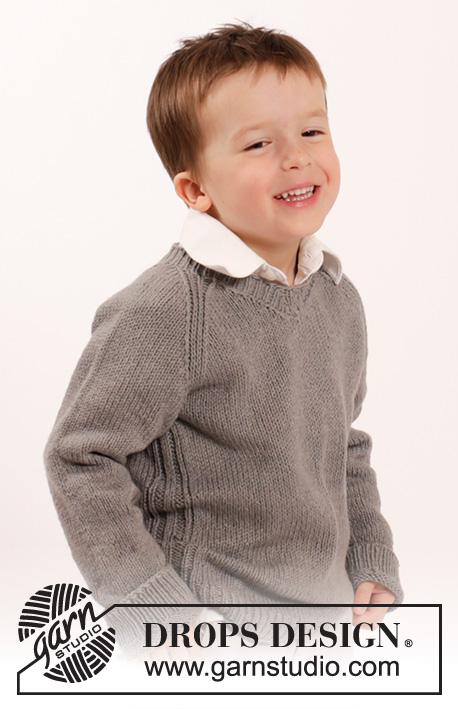 |
Knitted jumper with raglan and v-neck in DROPS Belle. Size children 2 - 10 years
DROPS Children 26-9 |
|
|
INCREASE TIP: Inc 1 st on each side of the middle 12 sts in each side (i.e. K 1, P 1, K 1, P 2, K 2, P 2, K 1, P 1, K 1). Inc 1 st by making 1 YO. On next round K YO twisted to avoid holes. RAGLAN: Dec for raglan on each side of 5 sts rib in every transition between sleeves and body. DEC AS FOLLOWS FROM RS: Beg 2 sts before 5 sts rib, K 2 tog, work 5 sts rib, slip 1 st as if to K, K 1, psso (= 2 sts dec). DEC AS FOLLOWS FROM WS: Beg 2 sts before 5 sts rib, P 2 twisted tog, 5 sts rib, P 2 tog (= 2 sts dec). DECREASE TIP 1 (applies to V-neck): Dec for V-neck inside 1 edge st. All dec are done from RS! Dec as follows after 1 edge st: Slip 1 st as if to K, K 1, psso. Dec as follows before 1 edge st: K 2 tog. DECREASE TIP 2 (applies to neck edge): Dec 2 sts as follows: Work until 1 st remains before K st mid front, slip 2 sts as if to K tog, K 1 and pass the 2 sts over. ---------------------------------------------------------- BODY: Worked in the round on circular needle. Cast on 146-154-166-174-182 sts on circular needle size 3 mm with Belle. K 1 round. Insert 1 marker in each side = 73-77-83-87-91 sts between markers. Work next round as follows: K 1, P 2, * K 1, P 1 *, repeat from *-* 33-35-38-40-42 times in total (i.e. until 4 sts remain before marker, K 1, P 2, K 2 (marker is in the middle of these 2 sts), P 2, * K 1, P 1 *, repeat from *-* 33-35-38-40-42 times in total and finish with K 1, P 2 and K 1. Continue rib like this for 4 cm. Switch to circular needle size 4 mm, work next round as follows: K 1, P 2, K 1, P 1, work in stocking st until 5 sts remain before marker AT THE SAME TIME dec 10-10-12-12-12 sts evenly over these sts, P 1, K 1, P 2, K 2 (marker is in the middle of these 2 sts), P 2, K 1, P 1, work in stocking st until 5 sts remain before marker in the other side AT THE SAME TIME dec 10-10-12-12-12 sts evenly over these sts and finish with P 1, K 1, P 2 and K 1 = 126-134-142-150-158 sts on needle. Continue like this in stocking st with 10 sts rib in each side. REMEMBER THE KNITTING TENSION When piece measures 8-8-10-10-12 cm, inc 1 st on each side of rib-section in each side – READ INCREASE TIP (= 4 sts inc). Repeat inc when piece measures 16-16-20-20-24 cm = 134-142-150-158-166 sts. When piece measures 22-25-28-31-34 cm, cast off 6 sts in each side for armholes (i.e. 3 sts on each side of both markers) = 61-65-69-73-77 sts remain on front and back piece. Put piece aside and knit the sleeves. SLEEVE: Worked in the round on double pointed needles. Cast on 50-50-52-52-54 sts on double pointed needle size 3 mm with Belle. K 1 round. Then work rib = K 1/P 1 for 4 cm. Switch to double pointed needles size 4 mm and work in stocking st while AT THE SAME TIME dec 12 sts evenly on 1st round = 38-38-40-40-42 sts. When piece measures 6-7-7-8-10 cm, inc 2 sts mid under sleeve. Repeat inc every 2-2-2½-2-2 cm a total of 8-10-10-13-14 times = 54-58-60-66-70 sts. When piece measures 23-28-33-36-40 cm, cast off 6 sts mid under sleeve = 48-52-54-60-64 sts remain on needle. Put piece aside and knit another sleeve. YOKE: Slip sleeves on to same circular needle as body where armholes were cast off (without working them first) = 218-234-246-266-282 sts on needle. READ ALL OF THE FOLLOWING SECTION BEFORE CONTINUING: PATTERN: Beg at a raglan line on back piece and work in stocking st in the round but in every transition between body and sleeves work 5 sts rib as follows: P 1, K 1, P 1, K 1 and P 1 (i.e. 2 sts rib on body and 3 sts rib on sleeve). RAGLAN: AT THE SAME TIME on 1st round dec for RAGLAN – see explanation above (= 8 sts dec). Repeat dec for raglan every other round/row a total of 15-16-16-17-18 times and then every round/row a total of 4-5-6-6-7 times. V-NECK: When piece measures 27-31-34-37-41 cm, slip the middle st mid front on 1 stitch holder for V-neck. Then work back and forth on circular needle from mid front while AT THE SAME TIME dec for V-neck in each side towards mid front as follows - READ DECREASE TIP 1: Dec every other row (i.e. on every row from RS) until piece measures approx. 34-38-41-45-49 cm up to neck on back piece and all sts are dec. After all dec for raglan and V-neck, approx. 45-45-49-59-59 sts remain on needle and piece measures approx. 36-40-44-48-52 cm up to shoulder.Adjust to end with a WS row. NECK EDGE: 1st row= RS. Change to circular needle 3 mm and K all sts on needle. Knit up sts inside 1 edge st along the neck line, knit st from the thread, pick up sts inside 1 edge st along the other neckline and K to mid back. Join work and K 1 round while inc evenly to 76-80-86-92-92 sts. Then work rib in the round = K 1/P 1 - NOTE: St on stitch holder mid front is worked K, adjust rib accordingly. AT THE SAME TIME on 2nd round, dec 2 sts mid front - READ DECREASE TIP 2. Repeat dec every round until neck edge measures 3 cm, then cast off with K over K and P over P. ASSEMBLY: Sew seam under sleeve. |
|
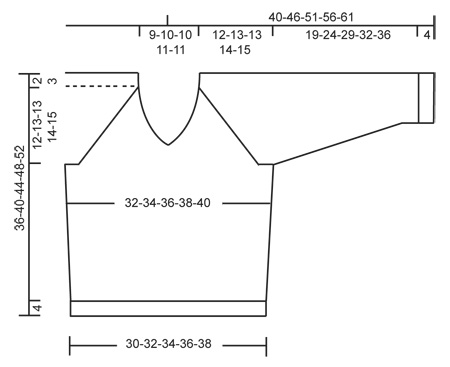 |
|
Have you finished this pattern?Tag your pictures with #dropspattern #funnyphilsweater or submit them to the #dropsfan gallery. Do you need help with this pattern?You'll find 30 tutorial videos, a Comments/Questions area and more by visiting the pattern on garnstudio.com. © 1982-2025 DROPS Design A/S. We reserve all rights. This document, including all its sub-sections, has copyrights. Read more about what you can do with our patterns at the bottom of each pattern on our site. |
|







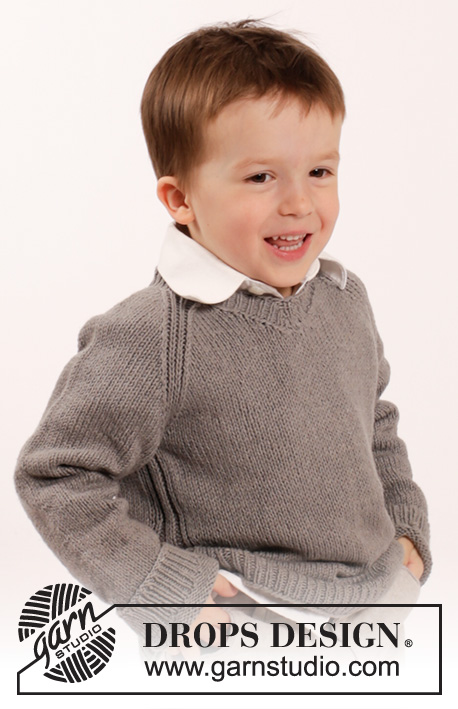

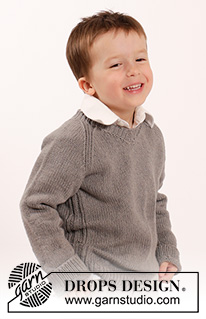
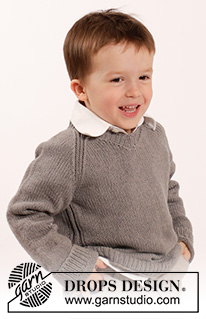





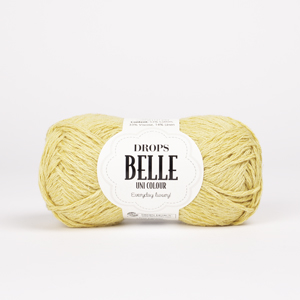


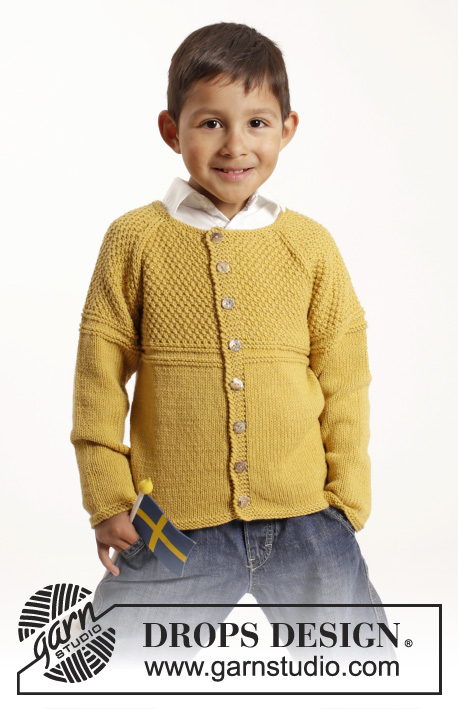



































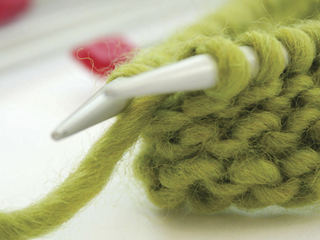










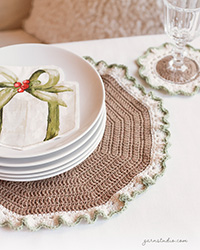
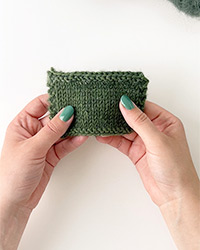
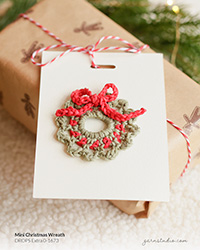
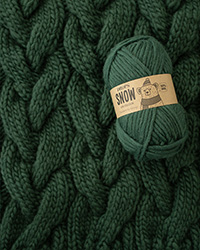
Post a comment to pattern DROPS Children 26-9
We would love to hear what you have to say about this pattern!
If you want to leave a question, please make sure you select the correct category in the form below, to speed up the answering process. Required fields are marked *.